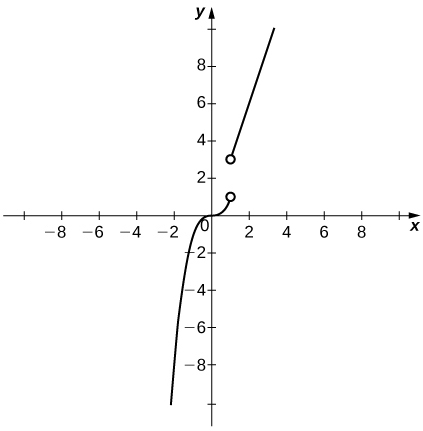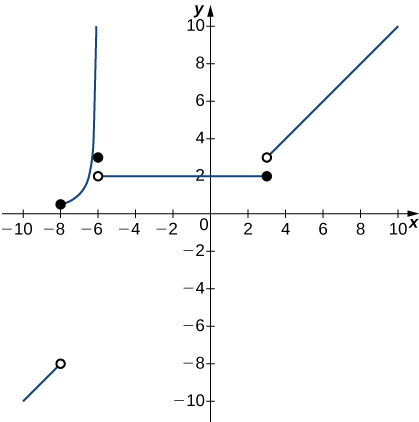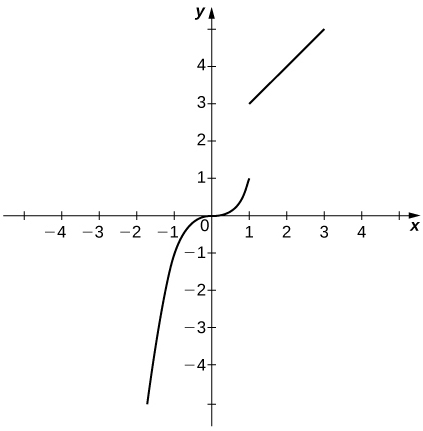2.4E: Exercises for Section 2.4
( \newcommand{\kernel}{\mathrm{null}\,}\)
For exercises 1 - 8, determine the point(s), if any, at which each function is discontinuous. Classify any discontinuity as jump, removable, infinite, or other.
1)
- Answer
- The function is defined for all
2)
3)
- Answer
- Removable discontinuity at
4)
5)
- Answer
- Infinite discontinuity at
6)
7)
- Answer
- Infinite discontinuities at
8)
For exercises 9 - 14, decide if the function continuous at the given point. If it is discontinuous, what type of discontinuity is it?
9)
- Answer
- No. It is a removable discontinuity.
10)
11)
- Answer
- Yes. It is continuous.
12)
13)
- Answer
- Yes. It is continuous.
14)
In exercises 15 - 19, find the value(s) of
15)
- Answer
16)
17)
- Answer
18)
19)
- Answer
In exercises 20 - 21, use the Intermediate Value Theorem (IVT).
20) Let
21) A particle moving along a line for time
- Answer
- Since both
22) [T] Use the statement “The cosine of
a. Write a mathematical equation of the statement.
b. Prove that the equation in part a. has at least one real solution.
c. Use a calculator to find an interval of length
23) Apply the IVT to determine whether
- Answer
- The function
24) Consider the graph of the function
![A diagram illustrating the intermediate value theorem. There is a generic continuous curved function shown over the interval [a,b]. The points fa. and fb. are marked, and dotted lines are drawn from a, b, fa., and fb. to the points (a, fa.) and (b, fb.). A third point, c, is plotted between a and b. Since the function is continuous, there is a value for fc. along the curve, and a line is drawn from c to (c, fc.) and from (c, fc.) to fc., which is labeled as z on the y axis.](https://math.libretexts.org/@api/deki/files/2012/CNX_Calc_Figure_02_04_201.jpeg?revision=1&size=bestfit&width=274&height=270)
a. Find all values for which the function is discontinuous.
b. For each value in part a., state why the formal definition of continuity does not apply.
c. Classify each discontinuity as either jump, removable, or infinite.
25) Let
a. Sketch the graph of
b. Is it possible to find a value
- Answer
-
a.

b. It is not possible to redefine
26) Let
a. Sketch the graph of
b. Is it possible to find values
27) Sketch the graph of the function
i. The domain of
ii.
iii.
iv.
v.
vi.
vii.
- Answer
-
Answers may vary; see the following example:

28) Sketch the graph of the function
i. The domain of
ii.
iii.
iv.
In exercises 29 - 30, suppose
29) Discontinuous at
- Answer
-
Answers may vary; see the following example:

30) Discontinuous at
Determine whether each of the given statements is true. Justify your response with an explanation or counterexample.
31)
- Answer
- False. It is continuous over (
32) If the left- and right-hand limits of
33) If a function is not continuous at a point, then it is not defined at that point.
- Answer
- False. Consider
34) According to the IVT,
35) If
- Answer
- False. Consider
36) The function
37) If
- Answer
- False. The IVT does not work in reverse! Consider
[T] The following problems consider the scalar form of Coulomb’s law, which describes the electrostatic force between two point charges, such as electrons. It is given by the equation
38) To simplify the calculation of a model with many interacting particles, after some threshold value
a. Explain the physical reasoning behind this assumption.
b. What is the force equation?
c. Evaluate the force
d. Is there any finite value of R for which this system remains continuous at R?
39) Instead of making the force
- Answer
Recall the discussion on spacecraft from the chapter opener. The following problems consider a rocket launch from Earth’s surface. The force of gravity on the rocket is given by
40) [T] Determine the value and units of
41) [T] After a certain distance
- Answer
42) As the rocket travels away from Earth’s surface, there is a distance D where the rocket sheds some of its mass, since it no longer needs the excess fuel storage. We can write this function as
In Exercises 43 - 44, prove each function is continuous everywhere.
43)
- Answer
- For all values of
44)
45) Where is
- Answer
- Nowhere

